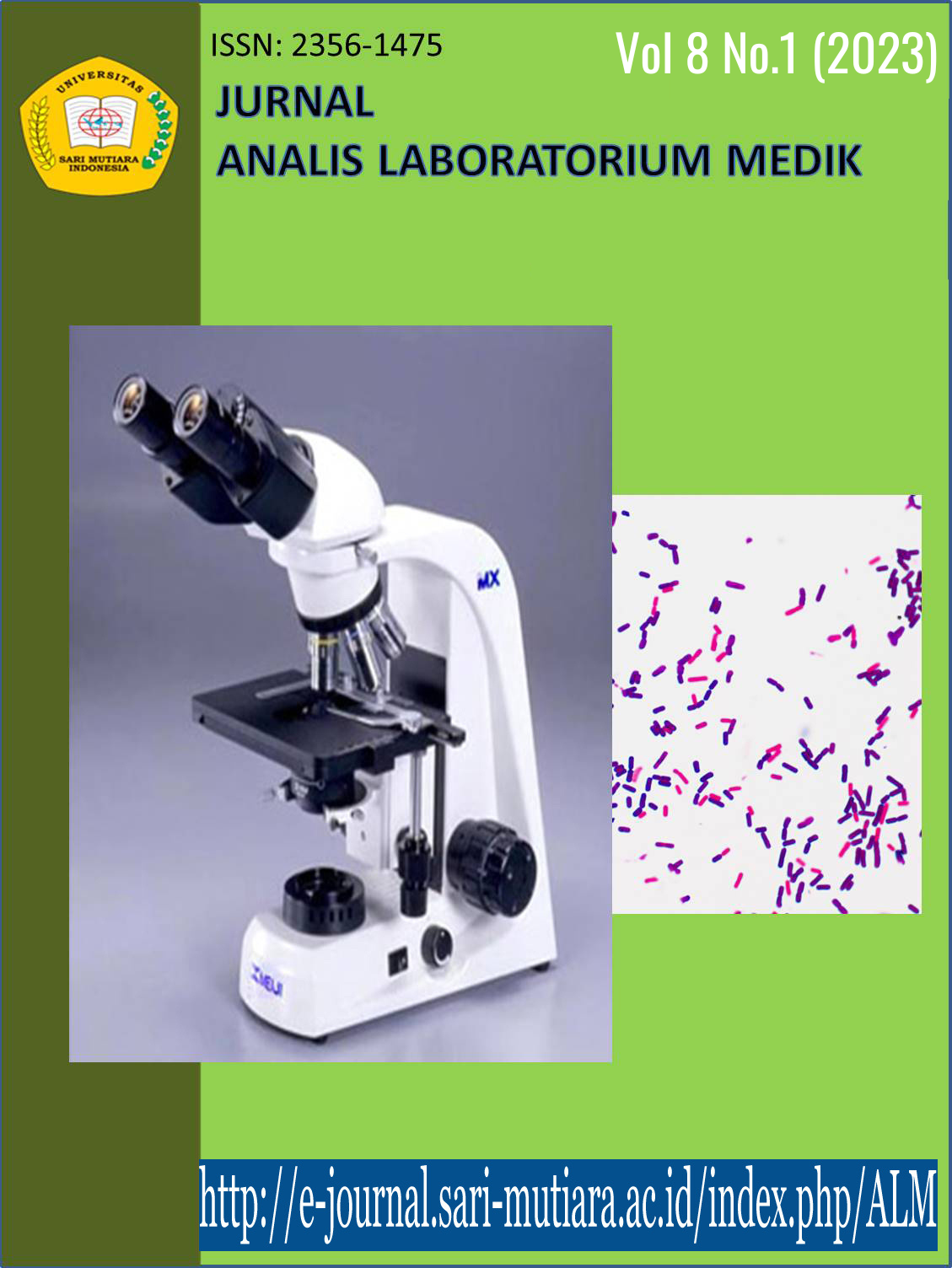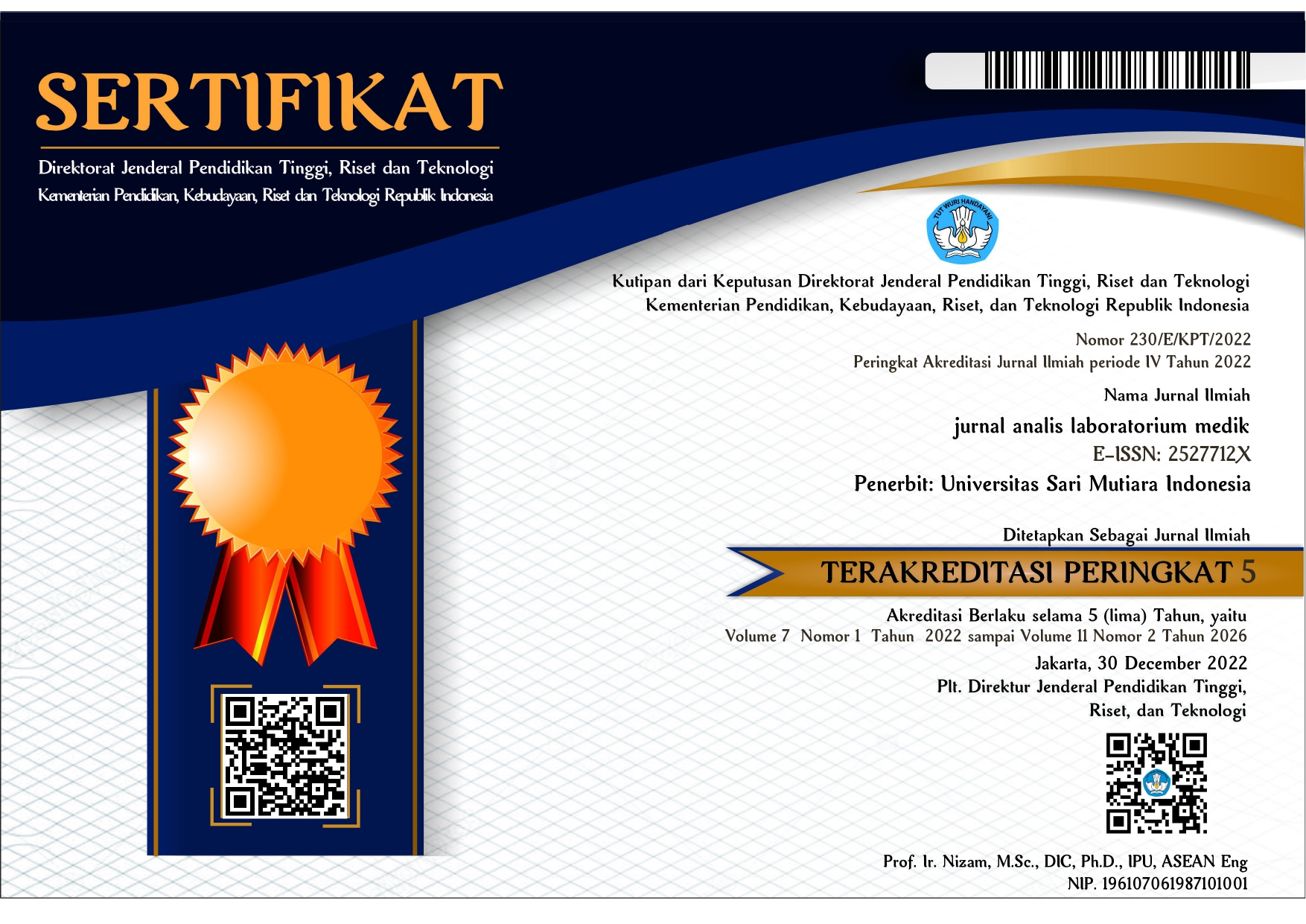FAKTOR-FAKTOR YANG MEMPENGARUHI PATOGENITAS TRICHOMONAS VAGINALIS
DOI:
https://doi.org/10.51544/jalm.v8i1.3799Keywords:
Trichomonas vaginalis, trichomoniasis, pathogenicityAbstract
Trichomonas vaginalis is a flagellated protozoan parasite that causes trichomoniasis. Trichomoniasis is a non-viral sexually transmitted infection and is found in the human urogenital tract. The interaction between T. vaginalis with the host is very complex and many factors influence the pathogenicity of T. vaginalis. To determine the factors that influence the pathogenicity of Trichomonas vaginalis. Literature review using the Google Scholar database. The search results for articles matched the criteria with the keyword "pathogenicity of Trichomonas vaginalis". Pathogenicity factors include changes in the trophozoite Trichomonas vaginalis to an ameboid form, cellular pathogenicity (attachment of Trichomonas vaginalis to host cells, cytotoxic and hemolytic activity, phagocytosis), interactions with vaginal flora, symbiont contribution with Trichomonas vaginalis, recognition by the host immune system, and evasion host immune system. Pathogenicity factors include changes in the trophozoite Trichomonas vaginalis to an ameboid form, cellular pathogenicity (attachment of Trichomonas vaginalis to host cells, cytotoxic and hemolytic activity, phagocytosis), interactions with vaginal flora, symbiont contribution with Trichomonas vaginalis, recognition by the host immune system, and evasion host immune system.
Downloads
References
Alderete, J. F., & Garza, G. E. (1985). Specific Nature of Trichomonas vaginalis Parasitism of Host Cell Surfaces. 50(3), 701–708.
Arroyo, R., & Alderete, J. F. (1989). Trichomonas vaginalis surface proteinase activity is necessary for parasite adherence to epithelial cells. Infection and Immunity, 57(10), 2991–2997. https://doi.org/10.1128/iai.57.10.2991-2997.1989
Arroyo, R., Cárdenas-Guerra, R. E., Figueroa-Angulo, E. E., Puente-Rivera, J., Zamudio-Prieto, O., & Ortega-López, J. (2015). Trichomonas vaginalis cysteine proteinases: Iron response in gene expression and proteolytic activity. BioMed Research International, 2015. https://doi.org/10.1155/2015/946787
Crouch, M. L., & Alderete, J. F. (1999). Trichomonas vaginalis interactions with fibronectin and laminin. Microbiology, 145(10), 2835–2843. https://doi.org/10.1099/00221287-145-10-2835
Crouch, M. L., Benchimol, M., & Alderete, J. F. (2001). Binding of fibronectin by Trichomonas vaginalis is influenced by iron and calcium. Microbial Pathogenesis, 31(3), 131–144. https://doi.org/10.1006/mpat.2001.0455
Fettweis, J. M., Serrano, M. G., Huang, B., Brooks, J. P., Glascock, A. L., Sheth, N. U., Strauss, J. F., Jefferson, K. K., & Buck, G. A. (2014). An emerging mycoplasma associated with trichomoniasis, vaginal infection and disease. PLoS ONE, 9(10). https://doi.org/10.1371/journal.pone.0110943
Figueroa-Angulo, E. E., Rendón-Gandarilla, F. J., Puente-Rivera, J., Calla-Choque, J. S., Cárdenas-Guerra, R. E., Ortega-López, J., Quintas-Granados, L. I., Alvarez-Sánchez, M. E., & Arroyo, R. (2012). The effects of environmental factors on the virulence of Trichomonas vaginalis. Microbes and Infection, 14(15), 1411–1427. https://doi.org/10.1016/j.micinf.2012.09.004
Fiori, P. L., Rappelli, P., & Addis, M. F. (1999). The flagellated parasite Trichomonas vaginalis: New insights into cytopathogenicity mechanisms. Microbes and Infection, 1(2), 149–156. https://doi.org/10.1016/S1286-4579(99)80006-9
Francisco Javier Rendón-Gandarilla 1, Lucero de Los Angeles Ramón-Luing, Jaime Ortega-López, Ivone Rosa de Andrade, Marlene Benchimol, R. A. (2013). The TvLEGU-1, a legumain-like cysteine proteinase, plays a key role in Trichomonas vaginalis cytoadherence. BioMed Research International. https://doi.org/10.1155/2013/561979
Garcia, Ana F.; Chang, Te-Hung; Benchimol, Marlene; Klumpp, David Jichael;Lehker, Michael W.; Alderete, J. F. (2003). Iron and contact with host cells induce expression of adhesins on surface of Trichomonas vaginalis. Mol Microbiol, 47(5), 1207–1224. https://europepmc.org/article/PMC/2562637
Gould, S. B., Woehle, C., Kusdian, G., Landan, G., Tachezy, J., Zimorski, V., & Martin, W. F. (2013). Deep sequencing of Trichomonas vaginalis during the early infection of vaginal epithelial cells and amoeboid transition. International Journal for Parasitology, 43(9), 707–719. https://doi.org/10.1016/j.ijpara.2013.04.002
Harp, D. F., & Chowdhury, I. (2016). Trichomoniasis: evaluation to execution Djana. Eur J Obstet Gynecol Reprod Biol, 34(5), 352–359. https://doi.org/10.1016/j.ejogrb.2011.02.024.Trichomoniasis
Kissinger, P. (2015). Trichomonas vaginalis: A review of epidemiologic, clinical and treatment issues. BMC Infectious Diseases, 15(1), 1–8. https://doi.org/10.1186/s12879-015-1055-0
Kusdian, G., Woehle, C., Martin, W. F., & Gould, S. B. (2013). The actin-based machinery of Trichomonas vaginalis mediates flagellate-amoeboid transition and migration across host tissue. Cellular Microbiology, 15(10), 1707–1721. https://doi.org/10.1111/cmi.12144
Mercer, F., & Johnson, P. J. (2018). Trichomonas vaginalis: Pathogenesis, Symbiont Interactions, and Host Cell Immune Responses. Trends in Parasitology, 34(8), 683–693. https://doi.org/10.1016/j.pt.2018.05.006
Mercer, F., Ng, S. H., Brown, T. M., Boatman, G., & Johnson, P. J. (2018). Neutrophils kill the parasite Trichomonas vaginalis using trogocytosis. PLoS Biology, 16(2), 1–25. https://doi.org/10.1371/journal.pbio.2003885
Mielczarek, E., & Blaszkowska, J. (2016). Trichomonas vaginalis: pathogenicity and potential role in human reproductive failure. Infection, 44(4), 447–458. https://doi.org/10.1007/s15010-015-0860-0
Okumura, C. Y. M., Baum, L. G., & Johnson, P. J. (2008). Galectin-1 on cervical epithelial cells is a receptor for the sexually transmitted human parasite Trichomonas vaginalis. Cellular Microbiology, 10(10), 2078–2090. https://doi.org/10.1111/j.1462-5822.2008.01190.x
Petrin, Dino; Delgaty, Kiera; Bhatt, Renuka; Garber, G. (1998). Clinical and Microbiological Aspects of Trichomonas vaginalis. Clinical Microbiology Reviewe, 11(2), 300–317. https://doi.org/DOI: 10.1128/CMR.11.2.300
Riestra, A. M., Gandhi, S., Sweredoski, M. J., Moradian, A., Hess, S., Urban, S., & Johnson, P. J. (2015). A Trichomonas vaginalis Rhomboid Protease and Its Substrate Modulate Parasite Attachment and Cytolysis of Host Cells. PLoS Pathogens, 11(12), 1–25. https://doi.org/10.1371/journal.ppat.1005294
Rizqoh, Debie; Hestina, H. (2018). Pemeriksaan Kista Protozoa Usus Kelas Mastigphora Pada Tinja Anak Usia 6-7 Tahun Sd N. 10 Pantansile Kecamatan Kutepanang Kabupaten Aceh Tengah. Jurnal Analis Laboratorium Medik, 3, 1–5. http://e-journal.sari-mutiara.ac.id/index.php/ALM/article/view/801
Rizqoh, Debie; Purba, D. (2017). Analisa Kista Protozoa Usus Kelas Mastigopora Pada Tinja Anak Usia 7-9 Tahun Di Sdn 014638 Desa Sei Nangka Kecamatan Sei Kepayang Barat Yang Barat Kabupaten Asahan. Jurnal Analis Laboratorium Medik, 2, 1–5. http://e-journal.sari-mutiara.ac.id/index.php/ALM/article/view/795
Schwebke, J. R., & Burgess, D. (2004). Trichomoniasis. 17(4), 794–803. https://doi.org/10.1128/CMR.17.4.794
Smyth, J. D. (1990). Foundations of parasitology (4th edn). In Parasitology Today (Vol. 6, Issue 3). https://doi.org/10.1016/0169-4758(90)90219-t
Valadkhani, Z. (2004). Role of pH on adhesion of trichomonas vaginalis isolated from symptomatic & asymptomatic women to vaginal epithelial cells in vitro. Iranian Journal of Medical Sciences, 29(3), 134–139.
Zahra Arab-Mazar, & Niyyati, M. (2015). Trichomonas vaginalis Pathogenesis: a Narrative Review. Novelty in Biomedicine, 3(3), 148–154. http://journals.sbmu.ac.ir/index.php/nbm/article/view/8288
Downloads
Published
How to Cite
Issue
Section
License
Copyright (c) 2023 Sresta Azahra, Lisawati Susanto

This work is licensed under a Creative Commons Attribution-ShareAlike 4.0 International License.
Syarat yang harus dipenuhi oleh Penulis sebagai berikut:
Â
- Penulis menyimpan hak cipta dan memberikan jurnal hak penerbitan pertama naskah secara simultan dengan lisensi di bawah Creative Commons Attribution License yang mengizinkan orang lain untuk berbagi pekerjaan dengan sebuah pernyataan kepenulisan pekerjaan dan penerbitan awal di jurnal ini.
- Penulis bisa memasukkan ke dalam penyusunan kontraktual tambahan terpisah untuk distribusi non ekslusif versi kaya terbitan jurnal (contoh: mempostingnya ke repositori institusional atau menerbitkannya dalam sebuah buku), dengan pengakuan penerbitan awalnya di jurnal ini.
- Penulis diizinkan dan didorong untuk mem-posting karya mereka online (contoh: di repositori institusional atau di website mereka) sebelum dan selama proses penyerahan, karena dapat mengarahkan ke pertukaran produktif, seperti halnya sitiran yang lebih awal dan lebih hebat dari karya yang diterbitkan. (Lihat Efek Akses Terbuka).










